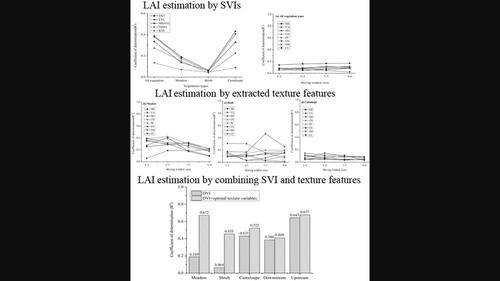Exploring the performance of spectral and textural information for leaf area index estimation with homogeneous and heterogeneous surfaces
引用次数: 0
Abstract
Leaf area index (LAI) is one of the key parameters of vegetation structure, which can be applied in monitoring vegetation growth status. Currently, abundant spatial information (e.g., textural information), provided by the developing remote sensing satellite techniques, could boost the accuracy of LAI estimation. Thus, the performance of spectral and textural information must be evaluated for different vegetation types of LAI estimation in different surface types. In this study, different spectral vegetation indices (SVIs) and grey‐level co‐occurrence matrix‐based textural variables under different moving window sizes were extracted from Landsat TM satellite data. First, the ability of different types of SVIs for LAI estimation in different surface types was analysed. Subsequently, the effect of different texture variables with different moving window sizes towards LAI estimation accuracy in different vegetation types was explored. Lastly, the performance of SVIs combined with textural information for the LAI estimation in different vegetation types was evaluated. Results indicated that SVIs performed better for LAI estimation in the homogeneous region than that in the heterogeneous region, and difference vegetation index was more remarkable for LAI estimation in different vegetation types than other SVIs. In addition, variations in texture variables and moving window sizes had a large influence on LAI estimation of natural vegetation with high canopy heterogeneity. SVI combined with textural information can efficiently improve the accuracy of LAI estimation in different vegetation types (R2 = 0.672, 0.455 and 0.523 for meadow, shrub and cantaloupe, respectively.) compared with SVI alone (R2 = 0.189, 0.064 and 0.431 for meadow, shrub and cantaloupe, respectively.). Especially for natural vegetation (meadow, shrub), the addition of textural information can greatly improve the accuracy of LAI estimation.

探索光谱和纹理信息在均匀和非均匀表面叶面积指数估计中的性能
叶面积指数(LAI)是植被结构的关键参数之一,可用于监测植被生长状况。目前,不断发展的遥感卫星技术提供了丰富的空间信息(如纹理信息),可以提高LAI估算的精度。因此,对于不同地表类型的不同植被类型的LAI估算,必须评估光谱和纹理信息的性能。本研究从Landsat TM卫星数据中提取不同移动窗口大小下的光谱植被指数(svi)和基于灰度共生矩阵的纹理变量。首先,分析了不同类型svi在不同地表类型下对LAI的估计能力。随后,探讨不同移动窗大小的纹理变量对不同植被类型下LAI估计精度的影响。最后,评价了基于纹理信息的SVIs在不同植被类型下的LAI估计性能。结果表明,SVIs在均匀区估算LAI的效果优于非均匀区,不同植被类型估算LAI的植被指数差异比其他SVIs更为显著。此外,纹理变量和移动窗大小的变化对冠层异质性高的天然植被LAI估算有较大影响。与单独使用SVI(草甸、灌丛和哈密瓜的R2分别为0.189、0.064和0.431)相比,SVI结合纹理信息能有效提高不同植被类型下LAI的估计精度(草甸、灌丛和哈密瓜的R2分别为0.672、0.455和0.523)。特别是对于天然植被(草甸、灌木),纹理信息的加入可以大大提高LAI估计的精度。
本文章由计算机程序翻译,如有差异,请以英文原文为准。
求助全文
约1分钟内获得全文
求助全文

 求助内容:
求助内容: 应助结果提醒方式:
应助结果提醒方式:


